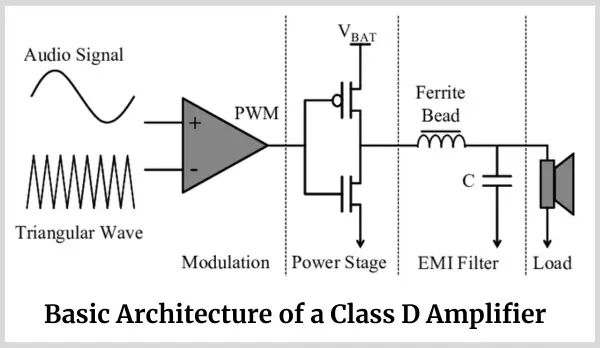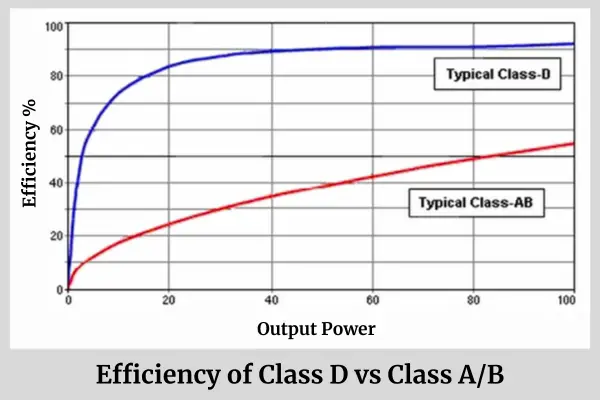What is a Class D Amplifier?
Curious about the tech magic that powers up your audio systems? At the heart of that magic lies an unsung hero: the amplifier. And when we dive deep into the world of amplifiers, there’s a buzz about Class D amplifiers. So, what is a Class D amplifier?
Before we unravel that mystery, let’s step back a bit. Amplifiers are crucial in audio and electronic systems. They take low-power audio signals and boost them, giving us the booming sound we crave in home theaters, concerts, and headphones.
Then there’s a range of amplifiers out there, with the most commonly used Class A, B, A/B, and Class D. Each has its unique qualities and applications. But for now, let’s zero in on the Class D amplifier, and see why it’s so popular.
Class A to Class D
Going back in time, the evolution of amplifiers is a journey from Class A to our current focus, Class D. So, what is a Class D amplifier and why was it born? Class A had its moments of glory. It brought us warm and pure tones, and then came the subsequent classes with their own perks.
But as technology surged ahead and our world demanded more, there was a growing need for amplifiers that wouldn’t just sound good but would also be energy-smart. Enter Class D.
Unlike its predecessors, it promised efficiency without compromising on the beats. This quest for efficiency and the relentless drive to innovate gave birth to the Class D amplifier, reshaping our audio experiences forever.

Basics of Class D Amplifiers
So, what is a Class D amplifier? Unlike its traditional counterparts, Class D amplifiers have carved out a distinct identity. While traditional amplifiers, such as Class A or Class A/B, operate in a linear mode—where they continually amplify the entire audio waveform—Class D amplifiers take a fundamentally different approach.
At the heart of this approach are techniques like Pulse Width Modulation (PWM) and Pulse Density Modulation (PDM). Instead of continuously amplifying, Class D amplifiers switch their output devices on and off rapidly.
PWM, for instance, varies the width of each pulse according to the audio signal’s amplitude. This rapid switching creates a series of pulses, which, when averaged out, reconstructs the original audio signal.
Now, these might sound like intricate terminologies, but in essence, they are the innovative processes that allow Class D amplifiers to be more efficient. They harness the power of modulation to shape the output waveform, creating a precise representation of the desired audio signal.
If you were to visualize the internal workings of a Class D amplifier, a block diagram would showcase a symphony of components, each designed and orchestrated. From input processing to modulation, and then to filtering, every component plays its pivotal role, ensuring the output audio is both accurate and pristine. This is where Class D amplifiers transform electrical theory into auditory art.
Advantages of Class D Amplifiers
Now let’s take a look at what makes Class D amplifiers stand out from the rest. Here’s a closer look at their advantages…
- Efficiency: One of the most defining traits of Class D amplifiers is their high efficiency. Unlike Class A, A/B, and B amplifiers, which continuously conduct electricity and often waste energy, Class D amplifiers use rapid on-off switching techniques. This means they’re only on when needed, conserving energy and reducing unnecessary power consumption.
- Size and Weight: In electronics, efficient designs often lead to reductions in component size. Since Class D amplifiers generate less heat due to their efficient operation, there’s a decreased need for large heat sinks and other thermal management components. This results in amplifiers that are compact and lightweight.
- Cost Efficiency: The efficiency of Class D amplifiers is not just about power conservation. This efficiency can also translate to cost savings. Manufacturing costs can be reduced due to fewer and smaller components. And, in terms of operational costs, using less power can lead to savings on electricity bills over time.
- Versatility: Class D amplifiers are known for their adaptability across various applications. Their efficient, compact design makes them ideal for home audio systems, car audio setups, and even portable electronic devices like Bluetooth speakers. Their performance remains consistent, whether they’re powering a large home theater system or a small handheld gadget.
Challenges and Limitations of Class D Amplifiers
While Class D amplifiers might be revolutionary, they aren’t devoid of hurdles. Every technology, no matter how advanced, faces its set of challenges, and Class D amplifiers are no exception.
One of the primary concerns is the potential for higher distortion. While these amplifiers are champions of efficiency, improper design can lead to the introduction of undesirable noise, marring an otherwise flawless audio experience.
Electromagnetic interference (EMI) is another obstacle. To draw a parallel, EMI can be likened to the unwanted static interference occasionally heard between radio stations. Due to the rapid switching actions inherent in their design, Class D amplifiers can suffer from EMI. This makes the inclusion of proper shielding imperative to prevent disturbances and maintain sound clarity.
And, the role of filtering in Class D amplifiers cannot be emphasized enough. Proper filtering ensures that the audio output remains pure and free from any extraneous interference. Neglecting this aspect can compromise the audio quality, akin to enjoying a fine cup of coffee only to find gritty residues at the bottom.
Lastly, when juxtaposed with other members of the amplifier lineage, opinions on Class D amplifiers can be polarized. While its efficiency and versatility are widely appreciated, some audiophiles may have reservations. They might discern subtle nuances and prefer the warmth and distinct tonal characteristics offered by amplifiers like Class A or A/B.

Applications of Class D Amplifiers
As you know, nothing is perfect, but the Class D amplifier is the most popular for good reason. Let’s take a look at where they’re best suited.
- Home Audio Systems: Many modern households rely on Class D amplifiers for their audio experiences. They’re integral components in home theater systems, ensuring clarity and depth in every sound from the subtle dialogues to the intense action scenes. Whether it’s surround sound systems or soundbars, Class D amplifiers are crucial in delivering optimal sound quality, enhancing our movie-watching experiences.
- Car Audio Systems: On the road, Class D amplifiers are integral to high-quality car audio systems. What makes them especially valuable in vehicles is their efficiency, ensuring rich sound without excessively draining the car’s battery.
- Portable Electronics: Class D amplifiers are not limited to stationary systems. They’re central to many portable devices, such as Bluetooth speakers and headphones. Whether you’re at a beach party or commuting, these amplifiers ensure your portable devices deliver crisp, clear, and immersive sound.
- Professional Sound Systems: When it comes to larger venues and events, Class D amplifiers are still at the forefront. Concert venues require amplifiers that can handle high power levels and deliver sound that reaches every attendee. Similarly, theaters need precise sound reproduction to accompany performances, and public announcement systems prioritize clarity and volume. In all these, Class D amplifiers provide reliable, top-tier performance.
What is a Class D Amplifier?
Having read this you should understand now what is a Class D amplifier. Beyond its technical definition, a Class D amplifier represents a leap in audio technology, distinguished by its efficiency and adaptability across a myriad of applications.
While every innovation has its intricacies and challenges, the Class D amplifier’s strengths and potential greatly overshadow its limitations, as is obvious by its popularity.
As the audio industry continues its rapid evolution, these amplifiers will evolve and certainly play an integral role in audio output.

I am a passionate and skilled car audio enthusiast with 15 years of experience in the industry. My journey started when I replaced my first set of factory car speakers, sparking a deep love for high-quality sound. Since then, I have worked as a representative for renowned brands like Kenwood and Alpine.
With a background in both retail and distribution, I have developed a comprehensive understanding of the car audio market. Currently a certified (MECP) installer in the Mobile Electronics industry, my expertise lies in delivering top-notch audio installations. My knowledge, coupled with my genuine passion, makes me the go-to professional for all car audio needs.


